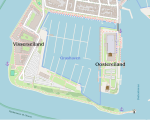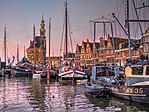Jewish cemetery, Hoorn

The Jewish cemetery in Hoorn can refer to the original Jewish cemetery on the outskirts of the Dutch city of Hoorn (where the first burial took place in 1762), or to a separate section of today's public cemetery. That Jewish section was opened in 1968, after the old Jewish cemetery was cleared for road construction. The history of the cemetery reflects that of the Jewish community in Hoorn, which started in the Dutch Golden Age, prospered in the 18th and 19th centuries, and declined in the 20th century, when the cemetery suffered from lack of maintenance. The Nazis ended what was left, and organizationally, the Jewish community of Hoorn merged with that of Enkhuizen. The current public cemetery of Hoorn commemorates the original cemetery, and has 219 gravestones from the original cemetery, and the remains of over 600 people.
Excerpt from the Wikipedia article Jewish cemetery, Hoorn (License: CC BY-SA 3.0, Authors, Images).Jewish cemetery, Hoorn
Provincialeweg, Koggenland
Geographical coordinates (GPS) Address Nearby Places Show on map
Geographical coordinates (GPS)
| Latitude | Longitude |
|---|---|
| N 52.646944444444 ° | E 5.0377777777778 ° |
Address
Provincialeweg
1624 NT Koggenland (Hoorn)
North Holland, Netherlands
Open on Google Maps









